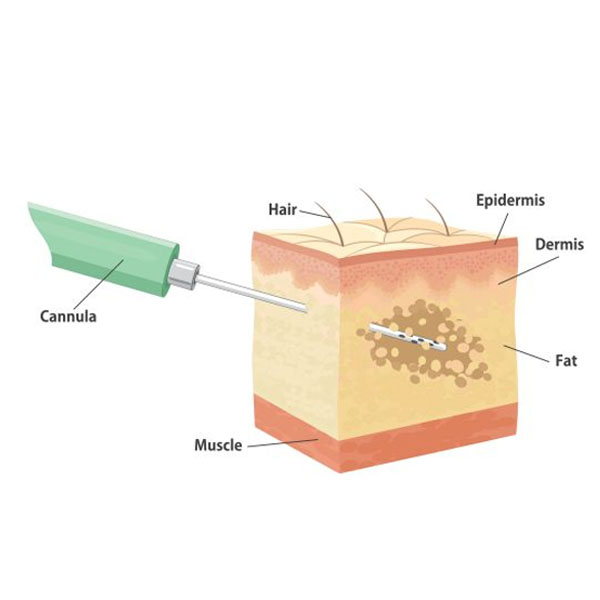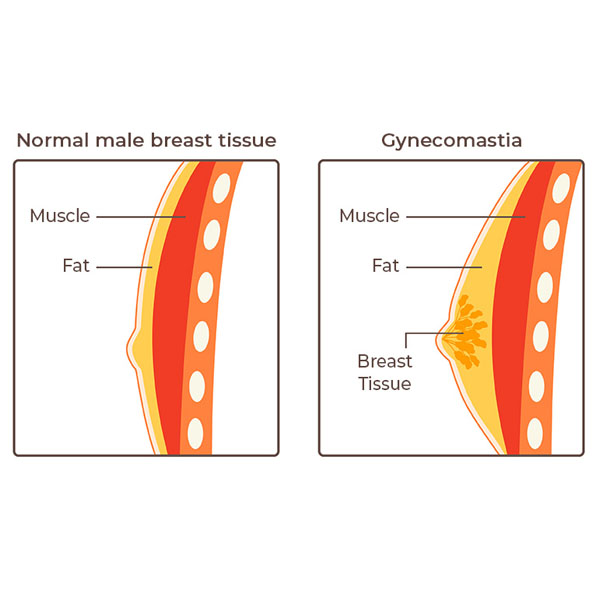Gynecomastia

Gynecomastia is a prevalent common condition in men characterized by the enlargement of male breast tissue. While it can affect males of all age groups, it is often observed during infancy, puberty, and later stages of adulthood. Various factors contribute to gynecomastia, with the most frequent cause being an imbalance between testosterone and estrogen hormones.
What is Gynecomastia?
Gynecomastia is a prevalent condition characterized by the enlargement of male breast tissue. While it can affect males of all age groups, it is often observed during infancy, puberty, and later stages of adulthood. Various factors contribute to gynecomastia, with the most frequent cause being an imbalance between testosterone and estrogen hormones.
Gynecomastia stands as the prevailing male breast disorder, with a global prevalence of approximately 50 to 65% among boys and men. This condition impacts a significant portion of the male population worldwide.
Who has gynecomastia?
Gynecomastia can manifest at different stages of life, including:
- Infancy: Breast buds and enlarged breasts are observed in over half of male newborns due to the presence of maternal estrogen. Typically, this condition resolves within a few weeks.
- Puberty: More than half of teenage boys experience some degree of breast enlargement. Fluctuating hormone levels, such as decreased testosterone and increased estrogen, contribute to the growth of breast tissue. As hormone levels stabilize, which usually takes six months to two years, the condition tends to resolve.
- Adulthood: Enlarged breasts are more commonly observed in men over the age of 50. As men age, testosterone production decreases while body fat increases. This can stimulate estrogen production and lead to the growth of breast tissue.
What are the causes of gynecomastia?
Gynecomastia is commonly triggered by an imbalance between estrogen and androgen hormones. Typically, men produce modest amounts of estrogen, which regulates breast growth. However, an overproduction of estrogen or low levels of testosterone (hypogonadism) can lead to breast enlargement. Additionally, individuals who are obese may develop enlarged breasts due to an excess accumulation of fatty tissue. This condition is referred to as pseudo gynecomastia.
Male breast enlargement, or gynecomastia, can be caused by various underlying conditions, including:
- Adrenal tumors: Certain tumors of the adrenal glands can disrupt hormone production and lead to gynecomastia.
- Alcoholism: Excessive alcohol consumption can affect liver function, which in turn can disrupt hormone balance and contribute to breast enlargement in males.
- Kidney disease or kidney failure: Impaired kidney function can impact hormonal regulation, potentially resulting in gynecomastia.
- Klinefelter syndrome: This inherited condition, characterized by the presence of an extra X chromosome in males (XXY), can cause hormonal imbalances and lead to the development of enlarged breast tissue.
- Liver disease: Liver conditions, such as cirrhosis or hepatitis, can disrupt hormone metabolism, potentially contributing to gynecomastia.
- Thyroid disease: Disorders of the thyroid gland, such as hypothyroidism or hyperthyroidism, can affect hormone levels and potentially lead to male breast enlargement.
Procedure for Gynecomastia Surgery
The gynecomastia procedure in Bangalore typically involves the following steps:

Step 1: Anesthesia
Prior to the surgery, anesthesia is administered to ensure your comfort during the procedure. The options may include intravenous sedation or general anesthesia, depending on your doctor's recommendation.

Step 2: Liposuction Technique
In cases where excess fatty tissue is the primary cause of gynecomastia, liposuction techniques are employed. This involves the insertion of a thin, hollow tube called a cannula through small incisions. The cannula is maneuvered back and forth to loosen the excess fat, which is then suctioned out of the body.

Step 3: Excision Technique
Excision techniques are utilized when glandular breast tissue or excess skin needs to be removed to correct gynecomastia. This approach may also involve reducing the size of the areola or repositioning the nipple to achieve a more natural male contour. The specific incision patterns employed depend on the individual's unique circumstances and the surgical preferences of the medical professional.

Step 4: Combination of Liposuction & Excision Techniques
In some cases, a combination of liposuction and excision techniques is employed to address gynecomastia. This approach allows for the removal of both excess fat and glandular tissue, as well as addressing any necessary modifications to the nipple and areola.
In Livglam Clinic in Bangalore, we recommend to consult with a qualified healthcare professional to determine the most suitable treatment approach for your specific condition. They will assess your individual needs and recommend the appropriate surgical techniques for your gynecomastia procedure.
How much does the Gynecomastia Surgery cost?
The cost of gynecomastia surgery, or male breast reduction surgery, in Bangalore, India, can differ based on various factors. These factors include the stage and extent of gynecomastia, the patient's condition, the complexity of the procedure, and the amount of fat to be removed. Typically, the cost ranges from Rs 40,000 to Rs 80,000, considering the surgery itself, dressings, and follow-up consultations. However, it's essential to consult with a qualified surgeon to obtain an accurate cost estimate tailored to your specific case. Additionally, ensuring that you receive safe and high-quality care should be a priority when choosing a surgeon for gynecomastia surgery.
Frequently Asked Questions:
The recovery period after gynecomastia surgery varies from person to person but generally takes around 1 to 2 weeks. It is important to follow post-operative care instructions provided by your surgeon to ensure proper healing and minimize complications.
Yes, the results of gynecomastia surgery are typically permanent. However, it's important to maintain a healthy lifestyle to prevent weight gain and hormonal imbalances that could potentially cause a recurrence of breast enlargement.
As with any surgical procedure, there are risks involved with gynecomastia surgery. These can include bleeding, infection, scarring, changes in nipple sensation, and asymmetry. However, choosing an experienced and qualified surgeon can help minimize these risks.
In many cases, gynecomastia surgery is considered a cosmetic procedure and may not be covered by insurance. However, if there is an underlying medical condition causing gynecomastia, such as a hormonal imbalance or tumor, insurance coverage may be available. It's best to check with your insurance provider to understand your coverage.
Yes, gynecomastia surgery can be combined with other procedures such as liposuction or body contouring to enhance overall results. Your surgeon will assess your specific needs and discuss any potential combination procedures during the consultation process.
Procedure Time:
- 2-5 hours
Full Recovery:
- 6 weeks
Anaesthetic:
• General
Back to work:
• After 2 weeks
Duration of results:
• Permanent
Results:
• Noticeable within 2 weeks
Temporary risks & complications:
• May include soreness, bleeding, persistent pain, and infection
• *Individual results and reactions may vary.
